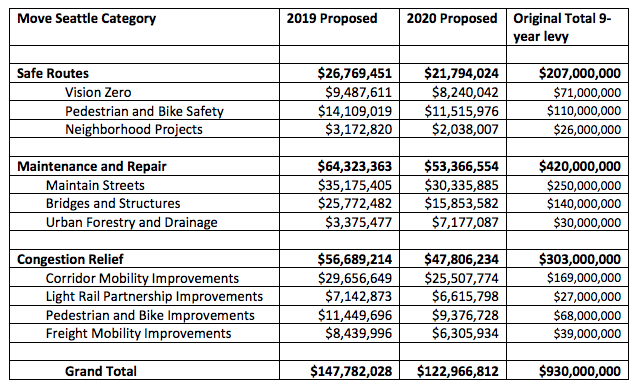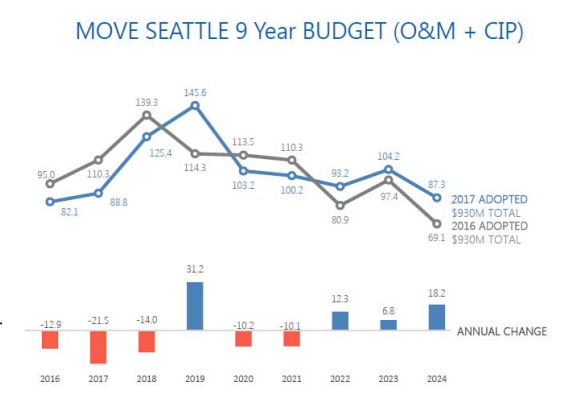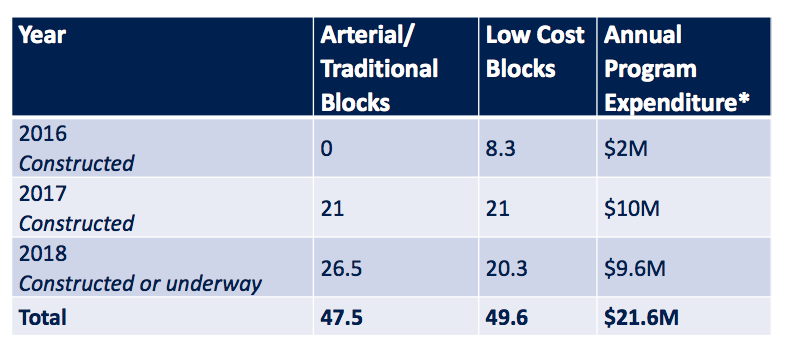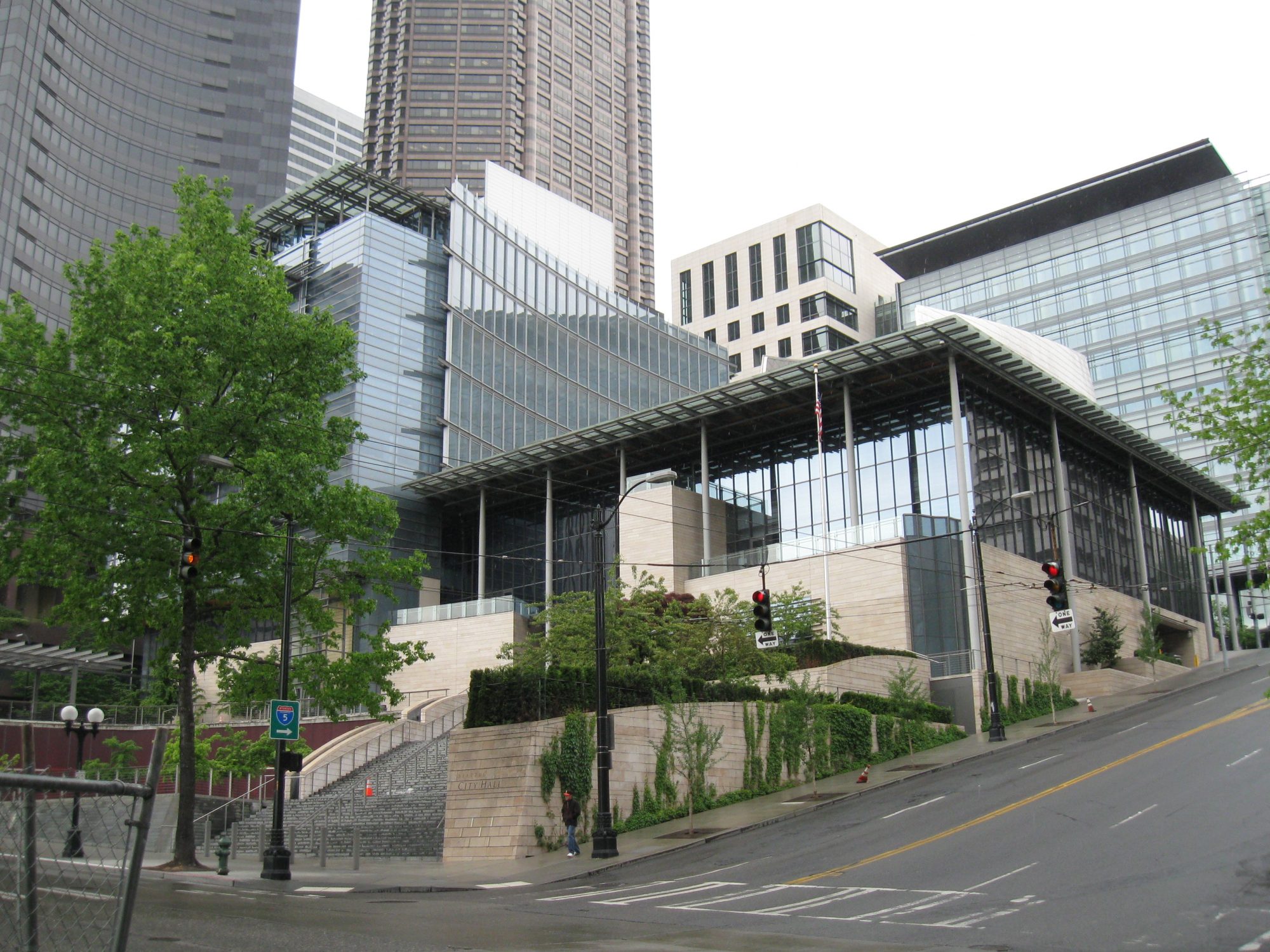The proposed budget for the next two years for the Seattle Department of Transportation (SDOT) includes so many different aspects it can be hard to get an understanding of exactly what is proposed, even after a review of the proposed budget documents. We will dig into the issues of what funds are coming from Move Seattle levy, the Seattle Transportation Benefit District, or other sources, and what exactly they are going toward.
Move Seattle funding
We don’t have a complete picture on what the year-long “reset” means for every single program that was planned over the life of the nine-year transportation levy, but there’s a lot to be learned from the proposed budget in terms of how on track the levy is.
2019 will be the fourth year of the levy, and the budget outlines SDOT’s biggest year yet for levy spending. Spending almost $148 million in one year is a $32 million increase over this year’s Move Seattle budget and is 40% of the amount that was spent over the life of the entire nine-year Bridging the Gap levy–Move Seattle’s predecessor.
Part of that big jump is large capital projects that finally get underway: the Fairview Bridge replacement, the Northgate pedestrian and bike bridge, and the S Lander Street overpass are all planned to make significant progress in the next two years. While we can’t see exactly what the breakdown in levy spending for those projects is, the total planned for those three projects over the span of the levy was $62.3 million, and another $1.1 million was added to this proposed budget to account for changes in project scope for the Northgate bridge. The Burke-Gilman Trail’s missing link is another big project set to start construction next year, with a total construction cost for that project of $12.5 million.

Move Seattle has carried forward a significant amount of unspent funds every single year that the levy has been in place so far: the first year of the levy, 2016, even after a mid-year downward revision of the levy spending budget, $29.4 was unspent and moved into the 2017. In 2017, in turn, according to documents presented to the Levy to Move Seattle oversight committee, $42.7 million carried over into 2018. Numbers from this year indicate that as of June, only $35 million had been spent so far, making it likely that the carry over amount will continue to snowball.
To what extent is the big bump in the Move Seattle budget for 2019 a result of that carry over? Not very much, according to documents from 2017 that show a revised levy spend amount for 2019 that is very close to the proposed budget that was released last month. In other words, that big bump up in spending has been planned since before the “reset” that is almost completed, analyzing every levy subprogram. But the increase in Move Seattle spending for 2020 looks like a result of spending needing to get back on track, and is likely to continue beyond that.

Extra Funding for Move Seattle Deliverables
The budget also includes funding from non-levy sources that are intended to complete levy goals, getting the department back on track to complete the promises made in 2015 at the ballot. Here are the main areas where those funds are focused.
- Curb ramps: As a part of the curb ramp settlement in 2017, the department needs to construct 1,250 ramps every single year until well into the next decade. The original Move Seattle levy commitment was only to fund improvements at 750 intersections, a much more broad target. The budget would add 12 full time employees to SDOT’s staff who would only work on curb ramp construction, as well as another $5 million for the curb ramps, a doubling of the $4.3 million currently budgeted. There will also be an employee added in capital management to provide back end support for the ADA ramp program. Fund source: Real estate excise taxes (REET) and school zone speed camera revenue.
- Signal work: The levy goal of improving traffic timing on five corridors per year would get four full-time employees devoted to it. Signal improvements appear to be a big focus of the mayor’s transportation budget, as we covered last week, as concerns around traffic congestion downtown are on everyone’s mind.
- New sidewalks: With the levy goal of 150 sidewalks increased to 250 at the last minute, sidewalk construction will be a major focus for the next few years. As of August, work was happening on the ground to bring the department up to 97.1 blocks of sidewalks, which includes around half as low-cost pathways (example below). An additional $3.8 million from school zone camera revenue will add to the $5 million per year already allocated through levy spending, bringing the total next year in planned spending to $19 million to build 41 blocks of both traditional and low-cost sidewalks next year to stay on track to hit the 250 block goal.
As of 2015, 11,794 blockfaces (one side of a four-sided block) lacked sidewalks, including 1,804 blockfaces of arterial streets (where most pedestrian collisions occur). So, we’re still working on an order of magnitude smaller than the deficit.

- Sidewalk repair: The original levy goal of 225 full blocks of sidewalks repaired proved to be more costly than originally anticipated, with many minor repairs on multiple blocks needing to be completed to be counted toward one full block. It looks like that target will be revised to become 1,000 spot repairs citywide per year- the 2017 sidewalk assessment found more than 150,000 defects on sidewalks in Seattle. This extra $4.1 million from camera revenue and REET will go toward meeting the new goal, with the camera revenue focused around school-adjacent areas.
- Neighborhood greenways: Likely more palatable for the current administration than protected bike lanes, which are becoming politically contentious, an additional $1.4 million in funding for greenways near schools with camera revenue will boost the overall bicycle project program and allow more of both types to meet the levy’s overall 60 mile target for greenways and 50 mile target for protected bike lanes, which is one of the most off-track programs mostly due to ancillary projects getting thrown in with complicated downtown bike projects. Another half million dollars will go toward the still-in-planning King Street neighborhood greenway to improve lighting along the corridor through the historic district.
- Arterial paving: A boost of $2 million for the Arterial Major Maintenance (AMM) program means more spot improvements that are more substantial than pothole repair but not as extensive as a multi-block repaving project.
All of these increases in spending across almost all areas at SDOT highlights a concern raised by Councilmember Rob Johnson at last Wednesday’s budget committee hearing: with a $128 million increase in SDOT’s budget they are only adding 13 full time employees to handle the increased workload for the department. At the direction of the mayor, city departments across the board are permanently cutting positions that have been vacant for more than a year, including 14 at SDOT. With 2019 having so many major projects, it’s hard not to look at the first three years of Move Seattle project delivery and wonder if the department is overextending itself.
As the budget process plays out, we will see if councilmembers make significant changes to the mayor’s proposed budget for SDOT. Councilmember Debora Juarez signaled during the budget committee last week that she was unsatisfied with the amount of new sidewalk funding going to District 5 and the transparency around bicycle projects. Councilmember O’Brien has already expressed a desire to slow down the rollout of pedestrian-hostile signal technology. As councilmembers turn in their green sheets to budget chair Sally Bagshaw, we will see what their priorities are.
Ryan Packer has been writing for The Urbanist since 2015, and currently reports full-time as Contributing Editor. Their beats are transportation, land use, public space, traffic safety, and obscure community meetings. Packer has also reported for other regional outlets including BikePortland, Seattle Met, and PubliCola. They live in the Capitol Hill neighborhood of Seattle.


